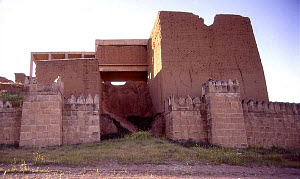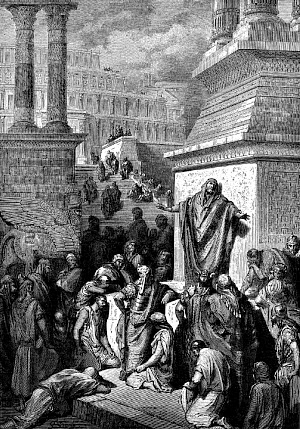What is…
Nineveh
also known as: Ninevah, Ninive, Ninua, Nīnawā
Hebrew: נִינְוֵה
The ancient city of Nineveh is first mentioned in Genesis 10.
Cush begot Nimrod; he began to be a mighty one on the earth. He was a mighty hunter before the Lord; therefore it is said, “Like Nimrod the mighty hunter before the Lord.” And the beginning of his kingdom was Babel, Erech, Accad, and Calneh, in the land of Shinar. From that land he went to Assyria and built Nineveh, Rehoboth Ir, Calah, and Resen between Nineveh and Calah (that is the principal city). —Genesis 10:8-12 NKJV
Nineveh is not mentioned again in Scripture till the days of Jonah, when it is described as a great and populous city, the flourishing capital of the Assyrian empire (2 Kings 19:36; Isaiah 37:37).
So Jonah arose and went to Nineveh, according to the word of the Lord. Now Nineveh was an exceedingly great city, a three-day journey in extent. —Jonah 3:3 NKJV
Then the Lord said, “…Should I not have compassion on Nineveh, the great city in which there are more than 120,000 persons who do not know the difference between their right and left hand…” —Jonah 4:10-11 NASB
The book of the prophet Nahum is almost exclusively taken up with prophetic denunciations against this city. Its ruin and utter desolation are foretold (Nah. 1:14; 3:19, etc.).
The Prophet Zephaniah also (Zeph. 2:13-15) prophecied its destruction along with the fall of the empire of which it was the capital.
From this time, there is no mention of it in Scripture till it is named in Gospel history (Matthew 12:41).
The men of Nineveh will stand up with this generation at the judgment and condemn it, because they repented at the preaching of Jonah; and behold, something greater than Jonah is here. —Luke 11:32 NASB
This “exceeding great city” lay on the eastern or left bank of the Tigris River, along which it stretched for some 30 miles, having an average breadth of 10 miles or more from the river back toward the eastern hills. Occupying a central position on the great highway between the Mediterranean and the Indian Ocean, thus uniting the East and the West, wealth flowed into it from many sources, so that it became the greatest of all ancient cities.
Nineveh is located at present-day Mosul, Nineveh Governorate, Iraq. Much excavation remains to be done. An ancient inscription found at the site says,
“Sennacherib king of the world …Over a great distance I had a watercourse directed to the environs of Nineveh…”
The Assyrian empire began to show signs of weakness, and Nineveh was attacked by the Medes, who subsequently being joined by the Babylonians and Susianians, again attacked it, when it fell, and was completely destroyed, flattened to the ground. The Assyrian empire then came to an end, the Medes and Babylonians dividing its provinces between them.
“After having ruled for more than 600 years with hideous tyranny and violence, from the Caucasus and the Caspian to the Persian Gulf, and from beyond the Tigris to Asia Minor and Egypt, it vanished like a dream” (Nahum 2:6-11).
Its end was strange, sudden, and tragic. It was God’s doing, his judgment on Assyria’s prideful wickedness (Isaiah 10:5-19 LSB).
…I will punish the fruit of the arrogant heart of the king of Assyria and the pomp of his haughtiness. —Isaiah 10:12 NASB excerpt
In fulfilment of prophecy, God made “an utter end of the place.” It became a “desolation.”
Until relatively recent times, our knowledge of the great Assyrian empire and of its magnificent capital was almost a complete blank. Vague memories had survived of its power and greatness, but very little was definitely known about it. Other cities which had perished, as Palmyra, Persepolis, and Thebes, had left ruins to mark their sites and tell of their former greatness; but of this city, imperial Nineveh, not a single vestige seemed to remain, and the very place on which it had stood was only matter of conjecture.
In the days of the Greek historian , 400 BC, it had become a thing of the past; and when Xenophon the historian passed the place in the “Retreat of the Ten Thousand,” the very memory of its name had been lost. It was buried out of sight, and no one knew its grave.

A reconstruction was begun in the 1960s by Iraqis, but was not completed. The result is an uneasy mixture of concrete and eroding mudbrick, which nonetheless does give one some idea of the original structure. The lower portions of the stone retaining wall are original. Fortunately, the excavator left some features unexcavated, allowing a view of the original Assyrian construction. The original brickwork of the outer vaulted passageway is well exposed.
The actions of Nineveh’s last defenders can be seen in the hastily built mudbrick construction which narrows the passageway from 4 meters to 2 meters. Height of the vault is about 5 meters. Photo by Fredarch.
At length, after being lost for more than two thousand years, the city was disentombed.
Palace after palace has been discovered, with their decorations and their sculptured slabs, revealing the life and manners of this ancient people, their arts of war and peace, the forms of their religion, the style of their architecture, and the magnificence of their monarchs. The streets of the city have been explored, the inscriptions on the bricks and tablets and sculptured figures have been read, and now the secrets of their history have been brought to light.
One of the most remarkable discoveries is that of the library of King Ashurbanipal, or, as the Greek historians call him, Sardanapalos, the grandson of Sennacherib. (See: Asnapper.) This library consists of about ten thousand flat bricks or tablets, all written over with Assyrian characters. They contain a record of the history, the laws, and the religion of Assyria, of the greatest value. These strange clay leaves found in the royal library form the most valuable of all the treasuries of the literature of the old world. The library contains also old Accadian documents, which are the oldest extant documents in the world, dating as far back as probably about the time of Abraham. (See Sargon.)
“The Assyrian royalty is, perhaps, the most luxurious of our century [reign of Assurbanipal]… Its victories and conquests, uninterrupted for one hundred years, have enriched it with the spoil of twenty peoples. Sargon has taken what remained to the Hittites; Sennacherib overcame Chaldea, and the treasures of Babylon were transferred to his coffers; Esarhaddon and Assur-bani-pal himself have pillaged Egypt and her great cities, Sais, Memphis, and Thebes of the hundred gates…
Now foreign merchants flock into Nineveh, bringing with them the most valuable productions from all countries, gold and perfume from South Arabia and the Chaldean Sea, Egyptian linen and glass-work, carved enamels, goldsmiths’ work, tin, silver, Phoenician purple; cedar wood from Lebanon, unassailable by worms; furs and iron from Asia Minor and Armenia” (Ancient Egypt and Assyria, by G. Maspero, page 271).
The bas-reliefs, Alabaster slabs, and sculptured monuments found in these recovered palaces serve in a remarkable manner to confirm the Old Testament history of the kings of Israel. The appearance of the ruins shows that the destruction of the city was due not only to the assailing foe but also to the flood and the fire, thus confirming the ancient prophecies concerning it.
“The recent excavations,” says Rawlinson, “have shown that fire was a great instrument in the destruction of the Nineveh palaces. Calcined Alabaster, charred wood, and charcoal, colossal statues split through with heat, are met with in parts of the Nineveh mounds, and attest the veracity of prophecy.”
Nineveh in its glory was an “exceeding great city of three days’ journey” (Jonah 3:4), i.e., probably in circuit. This would give a circumference of about 60 miles. At the 4 corners of an irregular quadrangle are the ruins of Kouyunjik, Nimrud, Karamless and Khorsabad. These four great masses of ruins, with the whole area included within the parallelogram they form by lines drawn from the one to the other, are generally regarded as composing the whole ruins of Nineveh.
- Assyria—What does the Bible say about it?
- Who is the Assyrian King Sennacherib, who lived at Nineveh?
- Who is Jonah?
- What is the Kingdom of Babylon (aka Babylonian Empire)?
- What are the Rivers of Babylon in the Bible
- About idolatry and false gods in the Bible
- Who is Nimrod? Was he godly or evil?
- Iraq in the Bible
- What is the significance of Iraq in the Bible?
- Who is Asnapper (aka Osnapper, Ashurbanipal)?
 What are the Cities of the Bible? Names, descriptions, locations and types
What are the Cities of the Bible? Names, descriptions, locations and types Bible archaeology discoveries
Bible archaeology discoveries


